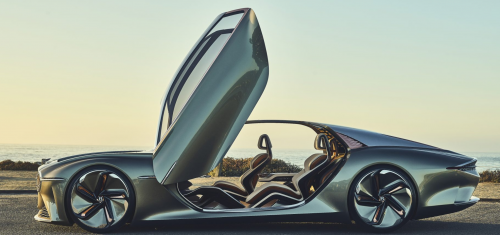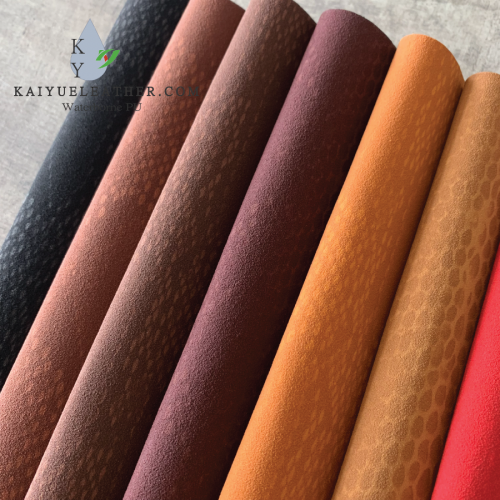Vegan leather made from grape skins and rice husks? Yes, Bentley said that in addition to the pursuit of electric, luxury car manufacturers like Bentley are meeting their customers’ demand for ethical materials.
“For me, it’s luxury, and putting your money somewhere that relates to your values.”

Anchor Image: Bentley’s vision for the future, the EXP 100 GT has a dramatic new face and two-metre-wide doors that open upwards to create a real sense of arrival.
(Image: Bentley)
It’s easy to imagine your average Bentley owner (or any other ultra-luxury car brand, for that matter) sitting in a lavish den somewhere, the Chesterfield sofa beneath them wrapped in perfectly aged leather and walls perhaps decorated with their hunting conquests.
For some, that’s a stomach-churning image. But the truth is, we’ve almost always related extreme wealth with the hides of departed animals, from chinchilla coats to the ivory keys on a grand piano.
But then, somewhere along the line, money changed. And while this new generation of the mega-rich seems just as happy to spend every bit as generously, they care more about where that money goes, their social conscience having followed them to the top of the (preferably unlogged, old-growth) corporate tree.
It’s left companies like Bentley scrambling to find new ways to appeal to them, and electric motors simply aren’t enough. So that means new materials, sustainably sourced. It means new vegan leathers. It means eco-friendly wood.
We’ve entered a new era of luxury defined by sustainability, and that’s a place we’ve never been before.
“Sure, some people buy on that tradition. But there’s also a much larger target group that don’t buy luxury cars who I think would be attracted to products with ethical authenticity,” says Bentley Chairman and CEO, Adrian Hallmark.
“We want to go into the materials themselves and the sourcing of those materials and ensure that they’re totally ethically and environmentally sustainable. And I believe this will be a USP for the brand if we get it right.”
Yes, change is coming to one of the oldest and most prestigious car brands on the planet, with Bentley suddenly eyeing the eco-friendly prize. Some of those changes are still off in the distance, while others are already here.
Take the Bentley EXP 100 GT, a sleek and stylish concept car designed to celebrate the brand’s storied 100-year history. It is one that also previews the very changes that will keep the company relevant for the next 100 years.
The EXP 100 GT is electric, of course. And it’s capable of driving itself autonomously. But the real secrets are hidden beneath its aluminium and carbon fibre exterior structure.
“We’re not yet at the point where we’re there with the current way that we do things, but we’re all becoming more enlightened,” Hallmark says. “We all see things differently now and we want to be ahead of that curve. So the thing about our EXP 100 GT, beyond the beauty of the design, the powertrain or the zero-emission tailpipe, is to showcase our vision for the interior.
“There are still some animal leathers inside, but only on the surface of the seat that you actually touch. Everything else is synthetic leather, which used to be made of organic solvents and contained DMF, DOP, formaldehyde and other VOCs. Now the latest environmentally friendly sustainable development of water-based vegan synthetic leather (Vegan leather), does not contain any harmful chemicals, zero VOC, green environmental protection, no pollution in the production process. All carpets are made of organic wool. All cotton is local Woven, locally sourced and free of chemicals.
The same is true for wool. And we know who raises and trims sheep, how to process them, how to deal with these things and where they go. You can identify all this information, including the name of the sheep from which the wool originated. Or all 16 people who have contributed their hairstyles to wear the carpet. ”
The new vegan leather produced exclusively in cooperation with Vegea of Italy, the raw materials are grape skins, stems and seeds, which are all by-products of the winemaking process. Wooden trim? It was made of oak trees that had been petrified 5,000 years ago, resulting in concrete-like veneers that were then reused by the Bentley team. It is based on the Finnish Basin of England, which is rare and expensive, and the price is 65 times higher than the wood that the company usually uses, which is more attractive to the target market of luxury brands.
Huai’an Kaiyue Technology Development Co., Ltd. also owns this technology, using water and rice husk as raw materials to make the leather production process pollution-free and zero VOC.

“It’s fallen wood, so it’s out of the CO2 cycle already,” Hallmark explains. “How many more of those kinds of materials can we find, and then upcycle if you like, into something that is pure luxury?
Even the exterior paint of the EXP 100 GT is produced from a process that uses recycled rice husks, a by-product of the rice industry.
“For me, it’s luxury, and putting your money somewhere that relates to your values. Customers are asking, ‘When can I have that?’ It’s that simple.”
This story first appeared in the January/February 2020 issue of A Magazine.